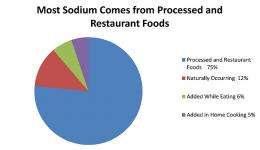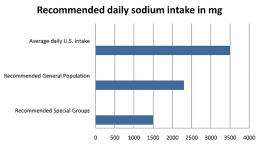Study Shows Not Everyone Has the Same Reaction to Salt

(PhysOrg.com) -- Some individuals may find a recent push by the federal government to reduce salt in processed foods hard to swallow. That's not because those individuals simply enjoy the salty taste of certain foods. A new study by University of Connecticut professor Valerie Duffy and graduate students in her Duffy Lab shows that some individuals need a higher degree of salt in their foods in order to block the unpleasant tastes they get from some of the things they eat.
These individuals - called “supertasters” - experience tastes more intensely, something that may be influenced by their individual genetics, the study says.
“Supertasters like snack foods, and these snack foods have saltiness as their dominant flavor,” says Duffy. “However, supertasters also need that salt to block unpleasant bitter tastes in foods like cheese. Cheese is a wonderful blend of dairy flavors from fermented milk, but it also has bitter tastes from ripening that are blocked with added salt. A supertaster finds low-salt cheese unpleasant, because the bitterness is too pronounced.”
One of the primary goals of Duffy’s research is to understand how chemosensory variation influences our ability to follow a healthy diet. The latest findings are important, she says, because it increases our understanding of salt preference and consumption, and helps explain why some people find low-salt foods less satisfying than others.
The study, recently published in the journal Physiology & Behavior, was a collaborative effort involving Duffy, a registered dietician and a professor of allied health science with a joint appointment in nutritional sciences; and two of her former graduate students from the Duffy Lab - John E. Hayes, now an assistant professor of food science at Penn State, and Bridget S. Sullivan, also a registered dietician who received her master’s degree from the Department of Allied Health Sciences in the College of Agriculture and Natural Resources in 2007.
In explaining the different levels of taste among individuals, the study relies on genetic science. Research by chemist Arthur Fox and geneticist Albert Blakeslee more than 75 years ago proved that genes play a role in dictating a wide range in individual taste acuity, just as they do in personal variations in eye or hair color. Supertasters, for example, describe bitter compounds like phenylthiocarbamide (PTC) and proplythiouracil (PTU) as being extremely bitter, while others, dubbed “nontasters,” find these compounds to be tasteless or only weakly bitter. This distinction is mainly due to each individual’s genetic make-up.
“Response to bitter compounds is one of many ways to identify biological differences in food preference, because supertasting is not limited to bitterness,” says Duffy. “Individuals who experience more bitterness from PTC and PTU also perceive more saltiness in table salt, more sweetness in sugar, more bitterness in coffee and grapefruit juice.”

“Supertasters live in a ‘neon’ food world,” Duffy says. “Nontasters, on the other extreme, live in a ‘pastel’ food world. Interestingly, nontasters may be more likely to add salt to foods because they need more salt to reach the same level of salt as a supertaster.”
The Duffy Lab is located in the College of Agriculture and Natural Resources. Lab research is funded in part by the National Institutes of Health, the U.S. Department of Agriculture, and the American Diabetes Association.
The salt study, “Explaining variability in sodium intake through oral sensory phenotype, salt sensation and liking,” tested 87 healthy adults (45 men, 42 women) who ranged in age from 20 to 40 years. The participants sampled regular and low-salt versions of such foods as chips, pretzels, cheese, soy sauce, and chicken broth. Data was collected in three laboratory sessions, usually one week apart. The testers used a standard scientific taste scale to differentiate degrees of taste from “barely detectable” to “very strong.”
How much salt people eat is important. Diets high in salt can increase the risk of high blood pressure and stroke. The National Institutes of Health and the American Heart Association recommend a diet for most adults containing no more than 2,400 mg (approximately one teaspoon) of sodium per day. But the recommended amount is much lower - 1,500 mg - for specific groups such as individuals with high blood pressure, African-Americans, and those over 40 years of age. With the average daily sodium intake in the U.S. currently hovering around 3,500 mg, the Food and Drug Administration recently launched a campaign to encourage commercial food manufacturers to reduce sodium in their products.
More than 75 percent of sodium in our diet comes from packaged, processed and restaurant foods, according to the Centers for Disease Control and Prevention (CDC). Only about 5 percent comes from salt added during cooking and about 6 percent comes from being added at the table. About 12 percent is naturally occurring or from other sources, according to the CDC.
“Currently, U.S. citizens consume two to three times the amount of salt recommended for health,” says Duffy. “Lower your salt intake by reading the food label and looking for products that are lower than 480 mg per serving.”
















